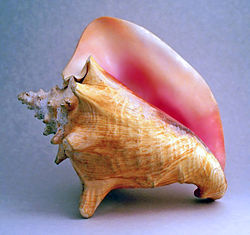Conch shell
Description
The Conch Shell is a large seashell played like a ceremonial fanfare trumpet. The volume depends on the style of blowing rather than breath volume capacity. In ancient times, the Conch Shell was sometimes used to accompany chants, and most often used to announce the beginning of a ceremony.[1]
Conch shells are sometimes made into crude bugles by removing the small tip of the shell to form a mouthpiece. Such instruments are used in the Pacific Islands as well as in many parts of Asia. While lacking the range capabilities and tonal quality of brass instruments, the conch shell is still an interesting instrument to play. As it has no mouthpiece or valves, the embouchure in shell playing is critical. Most shells will only naturally play one note, but with pitch manipulations, multiple sounds can be achieved. The insertion of the hand and the placement of the fingers will also change the pitch of the shell. The conch shell is said to be the musical instrument of mermaids and mermen. Steve Turre is the leading innovator of the shell. It is sometimes found in classical works, such as the symphony piece "La Noche de Los Mayas", or "Night of the Mayas", which was premiered in 1939 with Jacob Watkins on percussion and conch.[2]
Etymology and Alternative Spellings
Construction
The shell must first be emptied of its once living host. Most of the time, the shell has been cracked to release the vaccuum that is holding the animal in the shell. In order to make the horn, the hole must be sealed. Depending on the size of the hole, you could use an epoxy or even built up hot glue will work.
Once the shell is air-tight again, you can count about 3-4 rings from the tip of the shell to begin making a mouthpiece. You are looking for a mouthpiece similar in size to a trumpet or horn mouthpiece. Cutting the shell is a bit difficult with a hand tool, but could be accomplished with patience with a hack saw. A fine tooth blade on a band saw will also work very well, one that is suited for cutting metal will work the best.
After the opening is exposed where the mouthpiece will be, you will notice that there is a spiral shape don the center of the cup. This needs to be taken out. The easiest way to do this is to grind it down with a dremmel type of rotary tool. The material in the cup should be ground down and smooth to create a bowl shape. At this time, you should also round off the inside and outside edges of the mouth piece as this will help to make it more comfortable to play.
History
Technique
Manufacturers
Retailers
https://www.steveweissmusic.com
See Also
References
